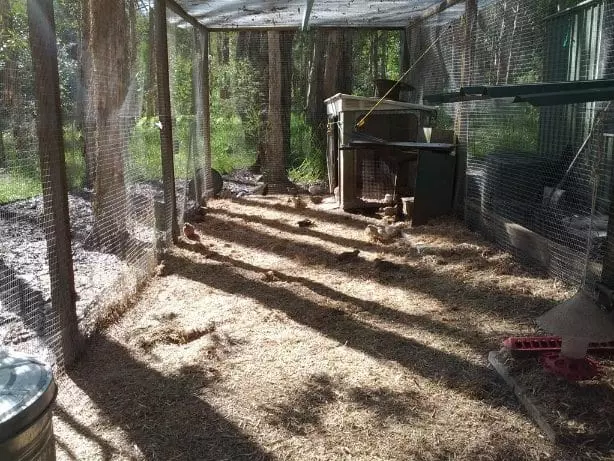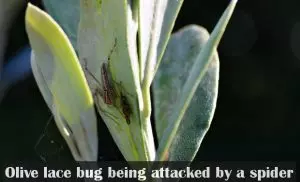Several months prior to this article I wrote a two part “How to” article on how to build a quail or chicken run. The interest in this article has been exciting to see and I'm glad this particular project is grabbing peoples curiosity as I wasn't sure if our readers would enjoy my DIY building tips but I'm glad they did.
This is a follow-up to the “How to build a quail or chicken run” in the form of lessons learnt. Not that I don't stand by everything in the original article, it's just that I've made some modifications/additions to the run and I want to detail them because I think it's important for anyone following my plan to know what I've since done to the project and how it's actually fairing.

The image above shows the inside of the quail run after river sand has been added and litter scattered around – outside the run the ground is still very wet and muddy.
Torrential rain
We all know how wet the subtropics can get; however, this rainy season saw record rain fall. The impact of this rain wasn't as severe as the floods last year because the downpours weren’t concentrated; nevertheless, due to the frequency of the falls the ground never had a chance to dry for months! And, this constant wet ground coupled with the long periods of rain was starting to take its toll on the birds.
Roofing over the run
This constant wet was beginning to make my quails miserable. Even though, the quails in the run had shelter like a converted cat cage and a dog kennel etc to hide from the weather, the sheer amount of rain meant they either had to stay in these small areas for lengthy periods or forage in the rain and the latter is what many of them did.
Therefore, the quails were getting wet and no doubt having a crappy cold evening once the sun set. I know what it's like to be wet through the night trying to sleep from my Army days and it isn't pleasant so I needed to fix the problem. 
Obviously, I decided to place a roof on the quail run. Luckily, the framework was already done as the run did have a roof (aviary wire) albeit not waterproof but a roof nevertheless. Hence, all I needed to do was simply attach my roofing material over the top of my existing wire roof using the wooden framework.
Poly clear roofing sheets is what I decided to use and the reason for this choice was to still let sunlight in to the run area. Unlike my chickens, which are free to roam around a large area and get some sun, the quail are confined to the run and I needed to be careful I didn't inadvertently take too much sunlight away. I still have housing and shaded areas for the quail to get out of the sun if they wish.
Materials
The materials for the roof job were as follows:
-
Poly corrugated roofing sheets clear (3m) x 10 @ $27 = $270
-
Galvanised roofing screws (40mil) x 100 @ $18 = $18
-
Pine roofing beams 75 x 50 mil x 2.4m x 3 @ $7 = $21
-
Galvanised joist holders x 6 @ $1.50 each = $9
-
Qty spare (whatever I had) galvanised nails and pine screws for the joist holders.
All up the roofing materials cost $318
How I did it
The run frame was 2.4 metres wide (all the beams and posts used in the project were 2.4m as this was the best pre-cut size I could get from my local hardware). So, I knew my width and I wanted some ov erhang for the roof on each side therefore 3 metre poly sheets fitted well.
erhang for the roof on each side therefore 3 metre poly sheets fitted well.
Before I positioned the poly sheets, I attached the 3 extra beams to the roof along the centre using the joist holders and this gave the framework some extra strength and ensured the poly sheets wouldn't slump in the middle.

Then it was just a matter of placing the poly sheets across the roof frame ensuring the corrugation on each sheet fitted neatly into the next. The sheets were attached to the wooden frame using roofing screws by screwing through a raised corrugation (not a dip) to guard against any unintended leaks.

The ground
Although the new roof was helping greatly to stop the precipitation, the quail run was still messy and muddy under foot and I needed to fix this problem also.
After removing most of the contents of the run (except the birds), I wheel-barrowed in three trailer loads (2 ton) of course river sand @ $45 per load and firmed it down by walking around on it.
The sand worked a treat and turned the muddy pen into a light gravelly/sandy surface about 6 inches deep where the water ran freely off/through and the birds could happily roam without getting overly dirty feet, plus, it made my getting around easier also.
On top of the sand I, threw some clean sugar cane mulch as litter for the run and positioned a few large concrete pavers around so the quails had some “hard-standing” if they required, especially around feed stations.
The addition of the sand and several pavers cleaned the run up beautifully – I should have thought about the flooring more at the start.
How is the rest of the run “fairing?”
Apart from the weather problem, I have been extremely happy with the quail run build and so have the birds.
Until a few weeks ago, I used to have two quail housing areas – this quail run and a raised cage/hutches made from an old children’s swing set (just the “A” frame). I was keeping my specialised breeders in the cage and although the cage was working well I felt it was time to integrate them into my much larger run.
Yes quail do fine in small spaces like cages; however, they definitely do look much happier when able to freely wander in a pen and scratch in the dirt or litter. I've found there is much less fighting too between the males and I think it's because there is plenty of space for rivals to seek a separate territory and to get out of the way if there's a disagreement.
Mice and rats have had a bumper season in this part of the world and rats are the mortal enemy of quails. This structure is totally rat proof and anyone who has ever seen the aftermath of a rat attack on quail would agree having a safe enclosure for their quail knowing rodents can't infiltrate is real peace of mind. The aviary mesh attached and dug-in around the whole frame really has been worth the effort and cost as not only is the run rodent proof the quail are totally safe from all predators including snakes, lizards, hawks, cats, and dogs.

Egg collecting obviously isn't as easy as when I housed my quail in cages but I'm happy enough to walk around and gather them up. Admittedly, I removed several smaller containers from the run, which were used as "hiding places" for some birds because I found the quail were sometimes laying under these areas and lifting the containers for egg collection became annoying. Now, the quail houses I have are large enough for easy access and egg collection. I guess egg searching and gathering is the main trade-off for having the birds in an open run but I have learnt a great deal about quail behaviour through observation and my inconvenience in gathering the eggs is worth it for the quail's welfare (in my opinion).
Conclusion
Luckily, the modifications I needed to do to the quail/chicken run didn't require any rebuilding or change to the original plan (more like additions than modifications). Nevertheless, I would have saved time and effort if I had done the roof and floor (sand) initially so for anyone following my plans, I recommend these “lessons learnt” be incorporated during the original build.
If you have your own thoughts on building a quail or chicken run why not make a comment in the section below (no email is required)?
Look, and see the Earth through her eyes
Mark Valencia – Editor SSM











